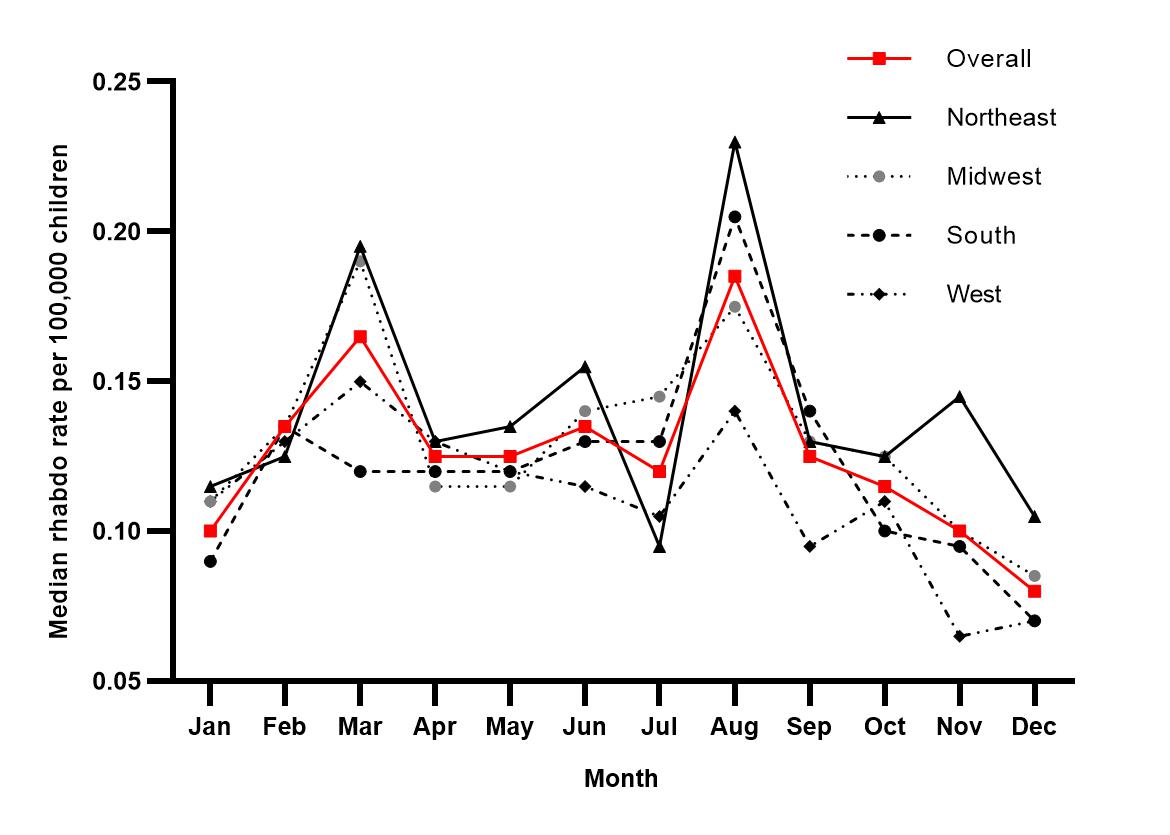Hospital Medicine: Systems/Population-based Research
Category: Abstract Submission
Hospital Medicine: Systems/Population Health
149 - Pediatric Rhabdomyolysis and Associated Renal Failure: A 10-year Population-Based Study
Monday, April 25, 2022
3:30 PM - 6:00 PM US MT
Poster Number: 149
Publication Number: 149.416
Publication Number: 149.416
Ladan Agharokh, University of Texas Southwestern Medical School, Dallas, TX, United States; Isabella Zaniletti, Children's Hospitals Association, Lenexa, KS, United States; Andrew Yu, University of Texas Southwestern Medical School, Dallas, TX, United States; Ben Lee, UT Southwestern, Dallas, TX, United States; Matthew Hall, Children's Hospital Association, Lenexa, Kansas, KS, United States; Derek Williams, Vanderbilt, Nashville, TN, United States; Karen M. Wilson, University of Rochester School of Medicine and Dentistry, Rochester, NY, United States

Ladan Agharokh, MD
Assistant Professor
University of Texas Southwestern Medical School
Dallas, Texas, United States
Presenting Author(s)
Background: Rhabdomyolysis in children is a highly variable condition with presentations ranging from asymptomatic myalgias to more severe complications like acute renal failure. There are limited studies in children describing the incidence and morbidity associated with rhabdomyolysis. Generalizable conclusions from these studies are limited by small size, data from a single context, or a limited number of study sites, resulting in wide variability in prevalence estimates.
Objective: The primary aim of this study was to establish the incidence of hospitalization for rhabdomyolysis among children in the United States. Within this population, we aimed to determine rates of renal morbidity and mortality, as well as demographic factors associated with increased renal morbidity or mortality.
Design/Methods: This was a retrospective analysis of the Healthcare Cost and Utilization Project (HCUP) Kids’ Inpatient Database (KID) for all pediatric hospitalizations (age < 21 years) in 2006, 2009, 2012, and 2016 with a primary diagnosis code for rhabdomyolysis. In 2016, this database contained 4,200 hospitals in 47 states. U.S. Census Bureau yearly population estimates by age group and geographic region were used to determine incidence and rates over time. Data was analyzed for trends over time, across geographic regions, and between months of the year. Multivariable logistic regression was used to identify characteristics associated with rhabdomyolysis-associated acute renal failure.
Results: From 2006-2016, there were 8599 hospitalized children with primary diagnosis of rhabdomyolysis. Overall hospitalizations for pediatric rhabdomyolysis is increasing over time, with geographic peaks in the South and Northeast regions, and seasonal peaks in March and August. Though acute renal failure was present in 8.5% of children requiring hospitalization for rhabdomyolysis, very few of these patients required renal replacement therapy (0.41%), and death was rare (0.03%). The characteristics most significantly associated with renal failure included male sex, age greater than 15 years, and non-Hispanic black race compared to non-Hispanic white race.Conclusion(s): Rhabdomyolysis is an uncommon disease process in children with infrequent rate of hospitalizations, though incidence has been increasing over time. Amongst patients that are hospitalized, a significant portion of patients can have associated renal failure, though severe complications continue to be rare. Clinicians should have a high index of suspicion for rhabdomyolysis in children during peak months, especially in geographic areas with higher incidence.
10-Year incidence of pediatric rhabdomyolysis by geographic region.jpg) Each geographic region’s rate of hospitalization for pediatric rhabdomyolysis is plotted by month and year from 2006 to 2016. The national rate is shown in red. There is a significant increase in the overall rate of hospitalizations for pediatric rhabdomyolysis, along with increasing numbers in the Northeast, Midwest, and Southern regions.
Each geographic region’s rate of hospitalization for pediatric rhabdomyolysis is plotted by month and year from 2006 to 2016. The national rate is shown in red. There is a significant increase in the overall rate of hospitalizations for pediatric rhabdomyolysis, along with increasing numbers in the Northeast, Midwest, and Southern regions.
Seasonal variation in incidence of pediatric rhabdomyolysis by geographic region For each geographic region, the average rate of hospitalization for rhabdomyolysis per 100,000 children from 2006-2016 is plotted by month of the year. The red line represents the national average monthly rate of hospitalization for rhabdomyolysis per 100,000 children.
For each geographic region, the average rate of hospitalization for rhabdomyolysis per 100,000 children from 2006-2016 is plotted by month of the year. The red line represents the national average monthly rate of hospitalization for rhabdomyolysis per 100,000 children.
Objective: The primary aim of this study was to establish the incidence of hospitalization for rhabdomyolysis among children in the United States. Within this population, we aimed to determine rates of renal morbidity and mortality, as well as demographic factors associated with increased renal morbidity or mortality.
Design/Methods: This was a retrospective analysis of the Healthcare Cost and Utilization Project (HCUP) Kids’ Inpatient Database (KID) for all pediatric hospitalizations (age < 21 years) in 2006, 2009, 2012, and 2016 with a primary diagnosis code for rhabdomyolysis. In 2016, this database contained 4,200 hospitals in 47 states. U.S. Census Bureau yearly population estimates by age group and geographic region were used to determine incidence and rates over time. Data was analyzed for trends over time, across geographic regions, and between months of the year. Multivariable logistic regression was used to identify characteristics associated with rhabdomyolysis-associated acute renal failure.
Results: From 2006-2016, there were 8599 hospitalized children with primary diagnosis of rhabdomyolysis. Overall hospitalizations for pediatric rhabdomyolysis is increasing over time, with geographic peaks in the South and Northeast regions, and seasonal peaks in March and August. Though acute renal failure was present in 8.5% of children requiring hospitalization for rhabdomyolysis, very few of these patients required renal replacement therapy (0.41%), and death was rare (0.03%). The characteristics most significantly associated with renal failure included male sex, age greater than 15 years, and non-Hispanic black race compared to non-Hispanic white race.Conclusion(s): Rhabdomyolysis is an uncommon disease process in children with infrequent rate of hospitalizations, though incidence has been increasing over time. Amongst patients that are hospitalized, a significant portion of patients can have associated renal failure, though severe complications continue to be rare. Clinicians should have a high index of suspicion for rhabdomyolysis in children during peak months, especially in geographic areas with higher incidence.
10-Year incidence of pediatric rhabdomyolysis by geographic region
.jpg) Each geographic region’s rate of hospitalization for pediatric rhabdomyolysis is plotted by month and year from 2006 to 2016. The national rate is shown in red. There is a significant increase in the overall rate of hospitalizations for pediatric rhabdomyolysis, along with increasing numbers in the Northeast, Midwest, and Southern regions.
Each geographic region’s rate of hospitalization for pediatric rhabdomyolysis is plotted by month and year from 2006 to 2016. The national rate is shown in red. There is a significant increase in the overall rate of hospitalizations for pediatric rhabdomyolysis, along with increasing numbers in the Northeast, Midwest, and Southern regions.Seasonal variation in incidence of pediatric rhabdomyolysis by geographic region
 For each geographic region, the average rate of hospitalization for rhabdomyolysis per 100,000 children from 2006-2016 is plotted by month of the year. The red line represents the national average monthly rate of hospitalization for rhabdomyolysis per 100,000 children.
For each geographic region, the average rate of hospitalization for rhabdomyolysis per 100,000 children from 2006-2016 is plotted by month of the year. The red line represents the national average monthly rate of hospitalization for rhabdomyolysis per 100,000 children.